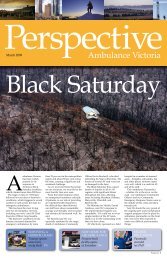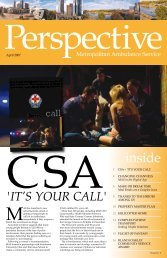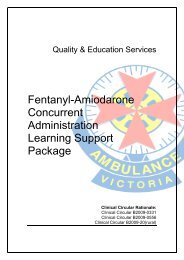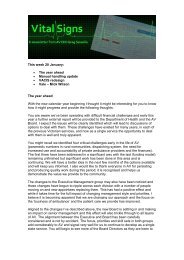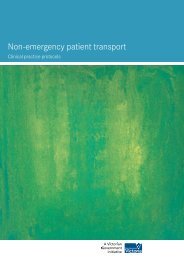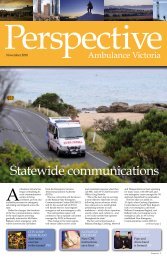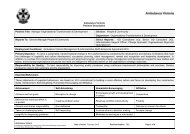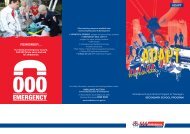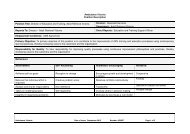VACAR Annual Report 2011/12 - Ambulance Victoria
VACAR Annual Report 2011/12 - Ambulance Victoria
VACAR Annual Report 2011/12 - Ambulance Victoria
You also want an ePaper? Increase the reach of your titles
YUMPU automatically turns print PDFs into web optimized ePapers that Google loves.
Data capture<br />
<strong>Ambulance</strong> <strong>Victoria</strong>’s in-field recording of patient data is conducted electronically using<br />
VACIS©, an electronic data capture system. All electronic patient care records (PCR) are<br />
automatically synchronised with organisational databases daily, providing an effective medium<br />
for the recording of clinical and administrative data. In addition, paper PCRs may be used in<br />
cases where in-field electronic data capture is not possible. These paper records are forwarded<br />
to the AV Accounts department or <strong>VACAR</strong> for storage and future review.<br />
To ensure the capture of all out-of-hospital cardiac arrest cases attended by AV, a broad<br />
electronic search is conducted of clinical databases utilising specific search criteria. This search<br />
strategy is focused at identifying potential cardiac arrest cases, which may be eligible for<br />
review. Furthermore, manual searching of paper records is conducted periodically by the<br />
<strong>VACAR</strong> research team to identify potentially eligible cases for review.<br />
Following review of potential cases, confirmed cardiac arrest cases are entered into the<br />
<strong>VACAR</strong> database, with PCR data being supplemented by information from communication<br />
centre dispatch records.<br />
The <strong>VACAR</strong> participating hospitals (i.e. ethics approved participation) are contacted for<br />
survival status and patient discharge direction. A cross-match of <strong>VACAR</strong> records with the<br />
<strong>Victoria</strong>n Registry of Births Deaths and Marriages is undertaken for verification of deaths.<br />
Structured telephone interviews are conducted twelve months post hospital discharge for<br />
patients identified as having survived cardiac arrest. The interview questionnaires used<br />
include: the Extended Glasgow Outcome Scale (GOS-E), SF-<strong>12</strong> ® Health Survey and EQ-5D<br />
questionnaires.<br />
Data quality assurance and quality control<br />
The <strong>VACAR</strong> undergoes rigorous data quality control to ensure the accuracy of data collected.<br />
During data entry, automated validation rules and error messages are embedded into the<br />
<strong>VACAR</strong> database to capture erroneous values or sequences. Quality control audits are<br />
conducted monthly on a random sample of 10% of cases to validate the accuracy of data coding<br />
by the <strong>VACAR</strong> research team. <strong>VACAR</strong> has undergone two independent external audits over<br />
the last decade, including an audit by the <strong>Victoria</strong>n Auditor-General’s Office.<br />
Cardiac arrest cases also undergo clinical auditing by AV’s clinical support officers. All cases<br />
where a patient requires defibrillation or where a death occurs in the care of AV undergo audit<br />
by a clinical support officer.<br />
Trend analysis is performed on a quarterly basis to ensure consistency of case numbers, patient<br />
outcomes and response times. Comparisons of these results are made with national and<br />
international data. Data verification spread sheets are performed routinely to identify<br />
inconsistencies with data coding, including the identification of error values and group<br />
outliers.<br />
<strong>VACAR</strong> <strong>Annual</strong> <strong>Report</strong> <strong>2011</strong>/<strong>12</strong> Page 17





